
Hawaii Volcanoes National Park currently charges an entrance fee of $30 per private vehicle (valid for seven days, covering up to 15 passengers). For those entering on foot or bicycle, the fee is $15 per person (visitors 15 and under are free), and for motorcycles it’s $25. An annual Hawai‘i Tri-Park Pass costs $55, allowing unlimited entry to this park, Haleakalā National Park, and Puʻuhonua o Hōnaunau National Historical Park for a year. America the Beautiful national park passes are also honored (an $80 annual pass covering all US national parks). Discounted or free passes are available for U.S. seniors (age 62+), active-duty military, veterans, visitors with permanent disabilities, and fourth-grade students, making the park accessible to a broad community.
The main section of the park (around Kīlauea Volcano) is open 24 hours a day, 7 days a week, including all holidays. In fact, we drove in for a late-night lava viewing without any issues at the gate. The Kīlauea Visitor Center is open daily from 9:00 a.m. to 5:00 p.m., offering maps, exhibits and helpful rangers. (Keep in mind that if you arrive very early or late when the entrance station is unstaffed, you can still enter by purchasing a pass online or using a self-pay station.)
The park’s more remote Kahuku Unit (a separate section about 70 miles southwest) is open Thursday through Sunday, 8 a.m. to 4 p.m. (closed Monday–Wednesday). Seasonal variations in operating hours are minimal since Hawaii’s daylight hours don’t change drastically, but certain areas or trails can temporarily close due to volcanic activity or safety concerns (for example, trail closures near active lava flows or high volcanic gas levels). We visited on 05 August 2025, and all figures were valid then.
Park Essentials: What Visitors Should Know
What makes Hawaii Volcanoes National Park so unique? For starters, it contains two of the world’s most remarkable volcanoes within its boundaries. Kīlauea is one of the planet’s most active volcanoes, with frequent eruptions that continually reshape the landscape. Adjacent stands Mauna Loa, the Earth’s largest shield volcano, towering 13,677 feet (4,169 m) above sea level.
Mauna Loa’s massive bulk and Kīlauea’s fiery temperament give the park a dual character that fascinated us. The park was originally established in 1916 (as part of the former Hawaii National Park) to protect these volcanic wonders and the surrounding ecosystems. Over the decades it’s also become a refuge for native Hawaiian flora and fauna and a living laboratory for volcanology. UNESCO recognized these exceptional natural features by designating the park as a World Heritage Site in 1987, and it’s listed as an International Biosphere Reserve for its biodiversity. In practical terms, this means you’re exploring a truly world-class environment that scientists and educators value highly.
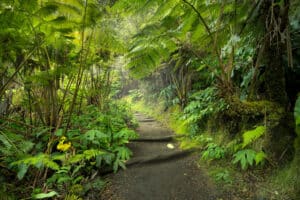
Lush rainforest in Volcanoes National Park Big Island Hawaii, USA
Geologically, the park is a dynamic wonderland. We stood on lava flows that were younger than we are – some trails traverse hardened lava from eruptions just a few years or decades ago. The landscape ranges from freshly blackened lava fields (looking almost lunar in their barrenness) to crater calderas like the vast Kīlauea Caldera and Halemaʻumaʻu crater at its center. One moment you might be peering into a steaming volcanic vent, and the next you’re walking through a lush fern forest. Pockets of rainforest, fed by the moisture on Kīlauea’s rainy eastern slopes, thrive surprisingly close to barren expanses of lava rock. These forests are dominated by ʻōhiʻa lehua trees and giant hāpuʻu tree ferns, creating an emerald contrast against the dark volcanic terrain. The park spans from sea level up to Mauna Loa’s high alpine wilderness, so multiple climate zones exist in one place. We experienced cool, misty rain at Kīlauea’s summit in the morning, then by afternoon we were down at the coast under a hot tropical sun near the ocean – all in the same day.
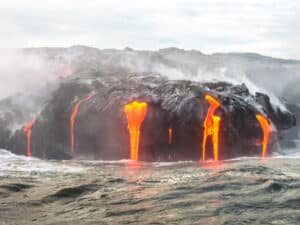
Close up of Kilauea Volcano, Hawaii Volcanoes National Park
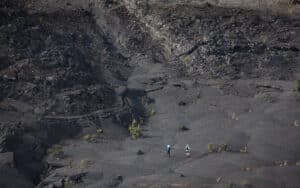
Hikers at Kilauea Iki Trail in Hawaii Volcanoes National Park
The ecosystems here are as intriguing as the geology. The isolation of the Hawaiian Islands has produced many endemic species found nowhere else. As we hiked, we spotted native birds like the endangered nēnē (Hawaiian goose) nibbling vegetation by the road. (Drivers are warned to slow down, since nēnē often hang out near roadsides – and we did indeed find them grazing calmly by the parking lots!). We also heard the songs of ‘apapane and ‘amakihi, colorful honeycreeper birds flitting among the ʻōhiʻa blossoms. Many of these species came back from the brink thanks to conservation efforts – for example, the nēnē has been actively reintroduced in the park after nearly going extinct mid-20th century. Endangered hawksbill sea turtles also nest on isolated beaches within the park’s coastal section, and park staff monitor and protect those nesting sites.
There is countless trails through these habitats, giving visitors a chance to witness how life recolonizes lava landscapes. In fact, hiking here often feels like walking through an ecology textbook: you see vegetation stages from bare rock with pioneer lichens and ferns to young forests in older, richer soils.
Culturally, Hawaii Volcanoes is equally rich. The park preserves important Hawaiian cultural sites amidst its wild terrain. Along some trails, we encountered ancient petroglyph fields (rock carvings) created by Native Hawaiians generations ago, recording their presence and traditions on the volcanic rock.
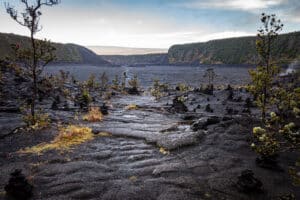
Kilauea Iki Trail in Hawaii Volcanoes National Park where you can walk across a volcanic crater.
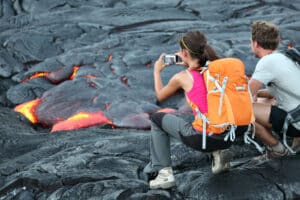
Tourists taking photo of flowing lava from Kilauea volcano around Hawaii volcanoes national park, USA.
At certain overlooks, interpretive signs share legends of Pele, the Hawaiian volcano goddess who is said to reside in Halemaʻumaʻu crater. These stories gave context to what we were seeing – reminding us that for Hawaiian people, this land wasn’t just geology, but home and history. The park’s mission includes protecting these archaeological sites and respecting their cultural significance. Rangers often give talks about how Polynesian settlers lived with the volcanoes’ cycles and even used the terrain (for example, carving trails across lava flows or using lava-heated rock pits to cook).
For visitors, the park offers a mix of driving routes, short walks, and longer hikes that showcase its highlights. The main road, Crater Rim Drive, circles Kīlauea’s summit (portions of it have been closed since a big eruption in 2018, but you can still access key viewpoints). Another must-do drive is Chain of Craters Road, which we took from the summit area down to the ocean.
Along that road, we stopped at multiple craters from past eruptions, and the route ends at a sea cliff overlooking the Pacific, near a formation called Hōlei Sea Arch – a picturesque lava rock arch by the waves. (This arch is eroding and will eventually collapse, but it was still intact when we saw it!). We’ve found that even a one-day visit can be very rewarding, but to truly appreciate everything, we recommend allocating at least two full days if you can. Our own itinerary was about a day and a half in the park, which let us hike a couple of trails and also do the scenic drives without rushing. Most casual visitors spend a full day here, while avid hikers or geology enthusiasts could spend several days exploring the backcountry (Mauna Loa’s summit hike, for example, is a multi-day adventure requiring serious preparation).
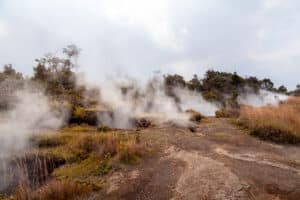
Volcanic Landscapes and Geothermal Vents at Hawaii Volcanoes National Park.
It’s worth noting that park management continuously works to preserve this environment. There are ongoing restoration projects aimed at removing invasive species like wild ginger and Australian tree ferns that can overrun native plants. We stumbled upon a fenced area where the park is testing ways to regenerate native forest by keeping out feral pigs and invasive goats.
The effort is paying off – inside these exclosures you see young koa tree saplings and other natives sprouting. Additionally, because wildfire is a concern even in a lush place (lava flows can ignite dry grasses, and the park’s leeward side is quite arid), the park has a fire management plan. We learned that rangers conduct controlled burns in some grassland areas to reduce invasive fountain grass that fuels wildfires, helping protect rare rainforest patches from accidental fires. And of course, volcanic safety is a major part of park management: when Kīlauea is erupting, certain zones are cordoned off and visitor access is carefully managed. (For instance, back in 2018 a large area was closed due to eruptive activity and earthquakes; even now, some crater rim trails remain off-limits for safety). All these measures ensure that Hawaii Volcanoes will remain a fascinating but safe destination for future generations.
Exploring Nearby: Trails, Landmarks & Eats
Beyond the main stops, we discovered plenty of additional things to see and do both inside the park and just outside its gates. Here are some of the highlights we experienced during our visit:
-
Thurston Lava Tube (Nāhuku): A surreal 500-year-old lava cave tucked in a dense rainforest. We took a short walk through this tunnel where molten lava once flowed. (It’s lit inside, but we recommend bringing a flashlight for fun, as some sections are dim and a bit dripping with water – it was kinda like entering the volcano’s plumbing!). Visiting early in the morning let us enjoy the lava tube in near solitude.
-
Kīlauea Iki Trail: Our favorite hike in the park – a 4-mile (6.4 km) loop that descends from the forested crater rim down onto a solidified lava lake bed. Ever wondered what it’s like to walk on the floor of a volcano? This trail answers that. We trekked across the still-steaming Kīlauea Iki crater floor (from a 1959 eruption) and then back up through lush jungle, all in about 2 to 3 hours. It was moderately challenging but very rewarding.
-
Devastation Trail: An easy, accessible walk (about 0.5 mile one-way) through a stark landscape of cinders from the 1959 eruption. The path is paved and flat – an eerie contrast with dead tree stumps standing in a sea of black cinder. We found it an effortless stroll with thought-provoking scenery, showing how violent eruptions can wipe an area clean.
-
Puʻuloa Petroglyphs: A short hike near the end of Chain of Craters Road that leads to one of the largest petroglyph fields in Hawaii. A boardwalk takes you over ancient carvings in the lava surface. We went out in the late afternoon and saw hundreds of pecked images – human figures, turtles, spirals – representing aspects of life for Hawaiians centuries ago. It was a humbling stop.
-
Volcano House: The historic lodge inside the park, perched on the rim of Kīlauea Caldera. Even though we didn’t stay overnight, we popped into its rustic lobby to check out the view. They have a restaurant with huge picture windows facing the smoking crater – we enjoyed a hearty lunch here, trying the local Big Island beef stew while gazing out at a live volcano. Talk about lunch with a view!
After our park adventures, we also explored the small village of Volcano just outside the park entrance, which offered some welcome food and relaxation. Despite its tiny size, Volcano Village has a handful of delightful eateries and stops that we tried out:
-
Kīlauea Lodge Restaurant: A charming, lodge-style restaurant (and inn) only a few minutes outside the park. We had dinner here by a crackling fireplace, surrounded by rustic Hawaiian décor. The menu features continental cuisine with island touches – we loved their fresh fish of the day and the homemade lilikoʻi (passionfruit) cheesecake for dessert. It was the perfect cozy spot to warm up after a cool evening of volcano viewing.
-
Thai Thai Bistro & Bar: To our surprise, Volcano Village boasts an excellent Thai restaurant. We craved something spicy one night and Thai Thai delivered – the Panang curry and pad Thai we ordered were delicious, and the portions were generous. The atmosphere was casual and family-friendly. It was fairly busy (this place has a great reputation), but service was prompt. If you’re gonna be in the area for a couple of days, this makes a nice change of pace from resort dining.
-
Ōhelo Café: This modern bistro was a lovely find for wood-fired pizzas and pasta. We dropped in for an early dinner without a reservation and managed to get a table. The pizza had a perfectly blistered crust and was topped with local veggies – simple and satisfying. They also offered local brews on tap. We noticed a mix of locals and park visitors here, giving it a friendly neighborhood vibe.
-
Volcano Art Center & Café Ono: Part gallery, part café, this spot is set in a rainforest garden. In the gallery, we browsed beautiful handcrafted artwork (paintings, lava-inspired ceramics, and koa wood carvings). Then at Café Ono on-site, we enjoyed a light vegetarian lunch – a flavorful pumpkin soup and a fresh salad – all made with organic ingredients. The relaxing garden setting, with chickens roaming around, made it a memorable midday break from our hiking.
-
Sunday Volcano Farmers Market: We were lucky to be around on a Sunday morning and visited the local farmers market (held near the community center in Volcano Village). It was a treat – we sipped on freshly brewed Kaʻu coffee, bought some sweet apple-bananas for snacks, and even indulged in a coconut pastry from a home baker’s stand. Chatting with the vendors gave us a sense of the community here. If you need picnic supplies or just want to experience local life, this little market is a must-do.
Throughout our visit, we picked up a few tips that made our experience smoother. For one, starting our days early was key – popular sites like the Thurston Lava Tube and certain lookouts were nearly empty before 9 a.m., but filled up with tour groups by late morning. We also learned that weather can be unpredictable: we always carried a light rain jacket along with sunscreen. And if you’re keen on lava viewing, check the park’s eruption updates online. During our trip, Kīlauea was intermittently active; we managed to see a faint orange glow after sunset from the designated overlook at Uēkahuna (near the old Jaggar Museum site). Arriving just before dusk, we secured a parking spot and joined a small crowd of enthusiasts watching the crater come alive in the dark. It wasn’t a dramatic fountain eruption this time, the subtle glow and the blanket of stars above made for an unforgettable moment.
Hawaii Volcanoes National Park gave us an experience that was both educational and awe-inspiring. We left with a deeper appreciation of how alive our planet is, and how the people and nature of Hawaii coexist with the volcanoes. Wandering among active craters and ancient forests in the same day felt like a journey through time – one we’d highly recommend to any traveler looking to truly feel the heartbeat of the Big Island.
Sorry, there were no items that matched your criteria.

